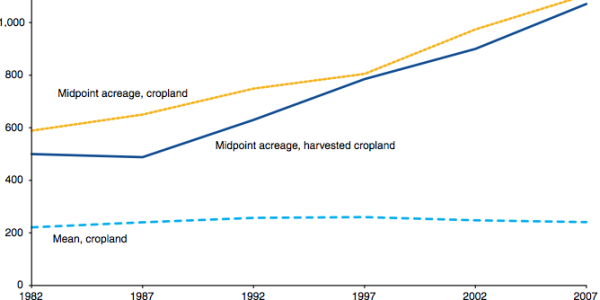By Lydia DePillis , Published: August 11 at 8:45 pm Picture your idea of a “family farm.” American Gothic ? Little House on the Prairie ? Maybe an idyllic 19th century life of cute cows and mowing hay? Yeah, everybody knows those don’t exist anymore, swept away by the forces of globalization and massive industrialized agribusiness. In one way that’s completely true–and in two other ways, it’s completely false, according to a new report out from the U.S. Department of Agriculture’s Economic Research Service. Let’s take the true part. Farms have gotten bigger, on average, when measured by the average number of acres under cultivation. The increase has been driven by several factors, including the development of high-tech equipment, seeds, and pesticides that made farming less labor intensive, increasing the returns to scale. Also, the rise of contracts means that farmers could lock in prices for their crops ahead of the harvest, allowing them to invest in that new technology (which may also have been accelerated by farm subsidies and the early-1990s disappearance of quotas that limited production). Farming got much more specialized, focusing on tremendous production of one commodity, rather than growing all kinds of veggies and livestock: But here’s the first untrue thing: Even while the average size of farms is going up, there are more small farms than ever, especially in small states with farmland preservation programs like Massachusetts and Rhode Island. Community-supported agriculture, plus the local and organic food movement, are starting to show up in the numbers. It’s the mid-sized farm, between 100 and 500 acres, that’s disappearing. And here’s the second thing that’s wrong about our understanding of the disappearance of family farms: 96.4 percent of the crop-producing farms in the U.S. are owned by families, and they represent 87 percent of all the agricultural value generated (non-family owned farms are defined as “those operated by cooperatives, by hired managers on behalf of non-operator owners, by large corporations with diverse ownership, and by small groups of unrelated people”). That hasn’t changed since about 1996. Part of the reason is that some mega-corporations have moved from direct ownership of cropland into a coordinating role, sourcing product from family-owned pieces of land that they’ve sold off. Also, families are just as capable of operating modern agricultural technology as agribusinesses are, as Chrystia Freeland described last year in the Atlantic. And finally, deep understanding of an area’s soil conditions and weather patterns– not to mention the local political landscape –are still valuable to productivity, which advantages families that pass such knowledge on through generations. That may not be the case forever. Ever-increasing size and specialization means that farms become riskier enterprises, able to be wiped out by a commodity price dip or unpredictable pathogen, which large corporations are better quipped to handle. And overseas, in places like Russia and Brazil, giant farms are developing monitoring techniques that could eventually make that local knowledge totally obsolete. In the mean time, though, just remember that when you say “family farm,” you might actually mean “small and relatively diversified farm,” though advocates for such operations might try to get you to think otherwise. Taylor Scott International
Farms Are Gigantic Now. Even The “Family-Owned” Ones

This entry was posted in Investment, investments, News, Property, Taylor Scott International, TSI, Uk and tagged calendar, chat, development, family-owned, farms, gigantic, investment, javascript, news, published. Bookmark the permalink.







